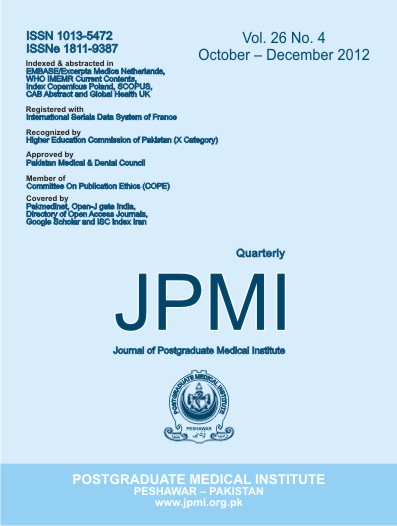TRENDS IN MATERNAL MORTALITY IN TERTIARY CARE HOSPITAL IN PESHAWAR - PAKISTAN
Main Article Content
Abstract
Objective: To report a 9 year review of maternal mortality ratio in the largest tertiary care hospital in Peshawar, Pakistan.
Methodology: Medical records of 371 maternal deaths were retrospectively reviewed to determine the trends & likely cause of each death over the study period.
Results: There were a total of 371 maternal deaths, while 36,460 deliveries were conducted over the 9 year period. The maternal mortality ratio (MMR) was 1017/100,000 live births. The highest MMR of 2015 / 100,000 was observed in 2001 and lowest was 759 / 100,000 in 2009. Hemorrhage consistently remained
the leading cause accounting for 38.89% of maternal deaths followed by Eclampsia, Suspected cases of pulmonary embolism & sepsis, each contributing 27%, 9.7% & 7% respectively. 45% of deaths were noted in older women (30y). Multiparas accounted for more deaths. Lack of seeking antenatal care was observed to be major determinant of maternal mortality.
Conclusion: The fall in MMR has been very slow. It still remains very high with hemorrhage being the main contributing cause. Improvement in the quality of skilled maternity care, community education on the need to avail antenatal care, provision of family planning services, among other factors, can drastically curtail the preventable causes of maternal deaths & reduce MMR.
Methodology: Medical records of 371 maternal deaths were retrospectively reviewed to determine the trends & likely cause of each death over the study period.
Results: There were a total of 371 maternal deaths, while 36,460 deliveries were conducted over the 9 year period. The maternal mortality ratio (MMR) was 1017/100,000 live births. The highest MMR of 2015 / 100,000 was observed in 2001 and lowest was 759 / 100,000 in 2009. Hemorrhage consistently remained
the leading cause accounting for 38.89% of maternal deaths followed by Eclampsia, Suspected cases of pulmonary embolism & sepsis, each contributing 27%, 9.7% & 7% respectively. 45% of deaths were noted in older women (30y). Multiparas accounted for more deaths. Lack of seeking antenatal care was observed to be major determinant of maternal mortality.
Conclusion: The fall in MMR has been very slow. It still remains very high with hemorrhage being the main contributing cause. Improvement in the quality of skilled maternity care, community education on the need to avail antenatal care, provision of family planning services, among other factors, can drastically curtail the preventable causes of maternal deaths & reduce MMR.
Article Details
How to Cite
1.
Fahim F, Nabeel N, Utman N. TRENDS IN MATERNAL MORTALITY IN TERTIARY CARE HOSPITAL IN PESHAWAR - PAKISTAN. J Postgrad Med Inst [Internet]. 2012 Sep. 24 [cited 2026 Jan. 2];26(4). Available from: https://jpmi.org.pk/index.php/jpmi/article/view/1378
Issue
Section
Original Article
Work published in JPMI is licensed under a
Creative Commons Attribution-NonCommercial 2.0 Generic License.
Authors are permitted and encouraged to post their work online (e.g., in institutional repositories or on their website) prior to and during the submission process, as it can lead to productive exchanges, as well as earlier and greater citation of published work.


